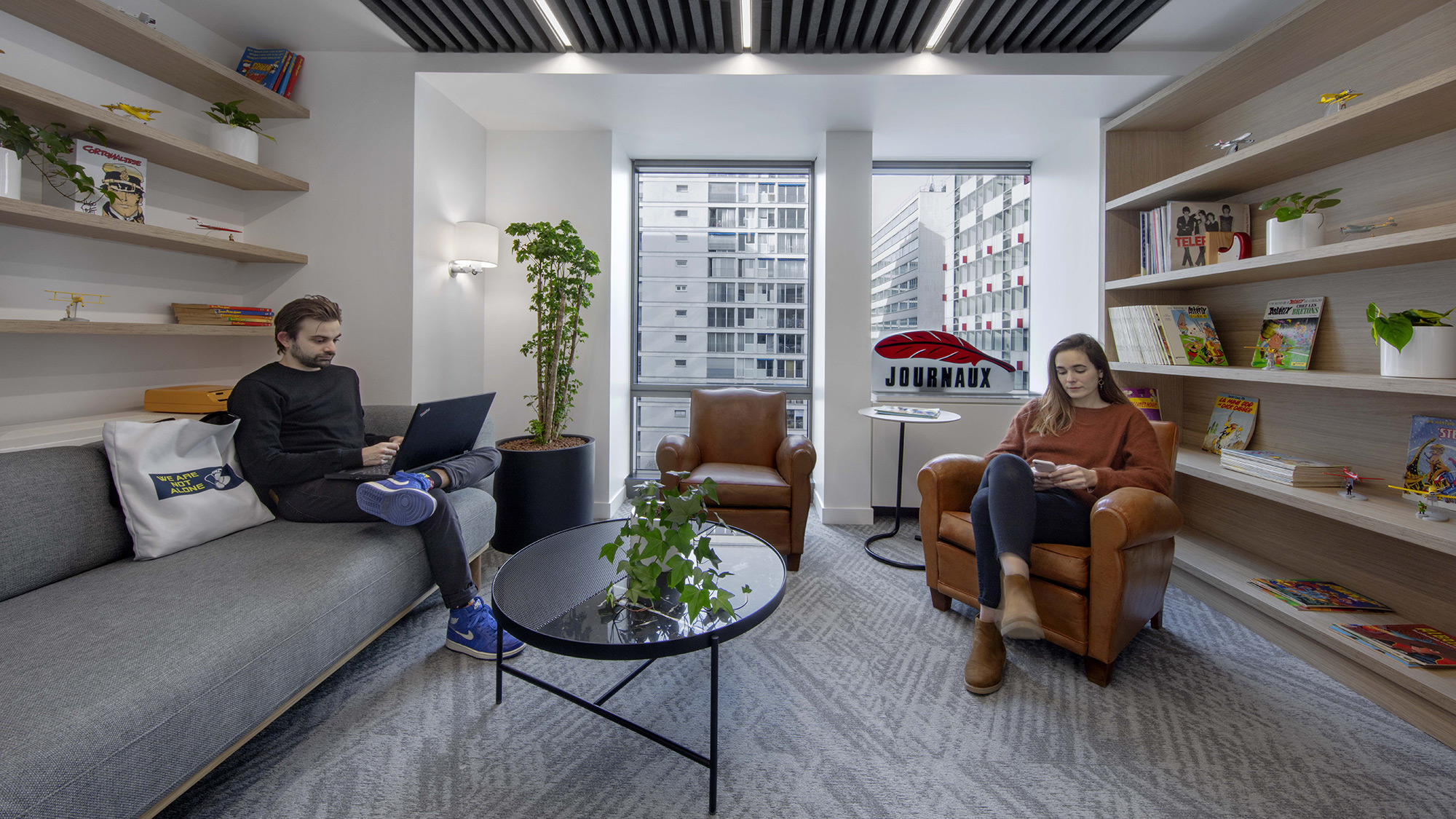Will Third Places Be the Future of Workplaces?
Les bureaux de demain seront-ils tous des Tiers-Lieux?
May 24, 2023 | By Jean-Pierre Bouanha
24 mai 2023 | Jean-Pierre Bouanha
We no longer need to define third places. Indeed, since the early 2000s, urban spaces — built or unbuilt — that are dedicated to multiple activities and purposes, such as art and social events, have emerged under this name. They were quickly institutionalised as symbols of acceptance, kindness, freedom, and social interaction, and often play a role in animating urban or suburban areas and developing new forms of transitional urbanism. This institutionalisation has marginalised the controversial character of the old, early-day squats.
Third places have gradually become physical (face-to-face) workspaces that encourage people to "produce" together: coworking, shared workshops, fab labs, shared common areas, etc., to foster collective intelligence and a wellbeing framework that is no longer imposed.
Meanwhile, the changes in traditional workplaces are pushing companies towards a greater awareness of employee wellbeing and work/life balance. In aid of this is the evolution of technology that has been making remote work and flexibility more and more achievable and sustainable.
Then came the COVID-19 health crisis at the start of 2020, with the first government regulation to require isolation. Remote work, which was once seen as a bargaining chip, is now the norm in the tertiary sector and is becoming more established in people's minds. Videoconference applications and remote access to company servers make this possible. We are therefore witnessing a small revolution that has an impact on the organisation of firms and their governance, and on the trend toward hybrid offices. Specialised property developers and business leaders alike are concerned about the future of physical office space, and this situation is causing them to reflect and react.

The health crisis has accelerated social changes already in place. The implementation of remote work has strengthened the idea that the physical office should be a place that makes people feel comfortable. Those involved in the construction or refurbishment of offices are taking inspiration from third places as they design the next generation of workplaces to make them smarter, cooler, more home-like, and more environmentally friendly. The primary objective is to create spaces that users feel good in, are proud of, and identify with.
Gardens should complement the designed spaces and reinforce the idea that offices can be a destination with a change of scenery into a haven of nature. The common areas of offices are based on the design codes found at home (decoration, objects, furniture, atmosphere, functionality, etc). They also incorporate the notion of versatility, with the ability to transform or reconfigure themselves. It is now important to promote unexpected interaction through more inviting workflow and features for exchange (bleachers, corridors, staircases, etc.). Some firms do not hesitate to support "domestic" rituals in these spaces, such as naps and games (tennis tables, video games, etc).
Just like third places, the time has come for the office to open up to the city, the neighbourhood, and the public space, rather than withdrawing into itself: corporate catering spaces are becoming accessible to the public, which gives them a more social purpose while at the same time making them a profitable business model. It's also time for the experience! In the era of social media and “Instagrammable” places or events, the office must also inspire the user with a sense of belonging within an aesthetically pleasing environment and provoke a “wow” or “cool” effect, which can even encourage the company's identity to be communicated to the public, at minimal cost, by its users.

New real estate professions are being developed around the creation of innovative services and unique features. Programming experts and operators such as Soffa in Lyon, Darwin in Bordeaux, and Cult Place in Paris are emerging. All these changes lead to an aesthetic, social, and environmental rethinking of the design of one of the most important elements of the city: the workplace.
From a social and urban alternative phenomenon born in France from 1945 to 1975, through to its official modern-day recognition, third places have influenced workplaces and contributed to the transformation of regions in different aspects: they are experimental life catalysts, in abandoned, unused places, which are begging to be revived. There is no “one-size-fits-all” approach to workplace design and we do not wish to create standardised models that ignore all context in favour of what is likely to work in the eyes of users (aesthetic appearance, fashion effect, etc).
Over the years, the term and the concepts of third places have become overused. If we are to reclaim codes of alternative models, such as the previously mentioned squats, we must ensure that we add another layer to innovate for the next generation of workplaces, rather than risk rejection for appearing repetitive. We are beginning to think of offices as “quarter-places” – not just a third place, but a space built to accommodate a combination of remote work, traditional office space, and the social aspects of third places. So, if this is becoming the office of today, and the ‘future of work’ is already here, what will it be like tomorrow?
For media inquiries, email .
On ne présente plus les Tiers Lieux. En effet, depuis le début des années 2000, des espaces urbains, bâtis ou non bâtis, et investis dans des fonctions et activités multiples allant de l’évènementiel à des pratiques artistiques et sociales, sont apparus sous cette dénomination. Ils se sont assez rapidement institutionalisés comme symboles d’accueil, de bienveillance, de liberté, de lien social et ont souvent participé à l’animation de zones urbaines ou péri-urbaines et ont participé à l’émergence d’une nouvelle forme d’urbanisme transitoire. Cette institutionnalisation a neutralisé la portée symboliquement subversive et engagée des anciens «squats» du début.
Ils sont peu à peu devenus des espaces de travail physique (en présentiel) qui incitent à «produire» ensemble: coworking, ateliers partagés, fablabs, lieux communs partagés…au service de l’intelligence collective et dans un cadre de bien-être moins imposé.
En parallèle l’évolution des lieux de travail traditionnels pousse les entreprises vers plus de considération du bien-être des salariés et de leur équilibre entre vie privée et professionnelle. En même temps, l’évolution de la technologie rend de plus en plus possible et viable, le télétravail et la flexibilité. Ces avancées se conjuguent avec l’avènement progressif des Tiers-Lieux qui deviennent une référence en termes de lien social, d’innovation, de rajeunissement des configurations de collaboration au travail, de mixité des programmes.
Arrive alors la crise sanitaire du Covid au début de l’année 2020 avec la première décision gouvernementale d’obligation du premier confinement. Le télétravail, qui en son temps, était perçu comme une revendication, devient la norme dans le secteur tertiaire, le temps de la crise, et s’installe dans les esprits. Les applications de vidéoconférence et l’accessibilité à distance aux serveurs d’entreprise, le permettent. On assiste alors à une petite révolution qui a des conséquences sur l’organisation des entreprises et leur gouvernance, et sur les tendances à l’hybridation des bureaux. La promotion immobilière spécialisée tout comme les dirigeants d’entreprises, s’inquiètent du devenir des espaces physiques de bureaux, et cette situation les pousse à s’interroger et à réagir.

La crise sanitaire a accéléré des phénomènes de société déjà à l’œuvre. Le déploiement du télétravail amplifie l’idée que le bureau physique doit être un lieu qui donne envie. Les acteurs de la construction ou de la réhabilitation de bureaux s’inspirent des Tiers Lieux sur la programmation dite des «bureaux de demain» afin de les rendre «plus smarts, plus cools, plus domestiques», plus «vertueux» avec pour objectif premier que les usagers s’y sentent bien, mais aussi qu’ils en soient fiers, qu’ils y adhèrent et s’y identifient.
Des jardins d’agrément ou productifs doivent accompagner les espaces créés, et renforcent l’idée que le bureau peut être dépaysant, écrin de nature. Les zones communes de bureaux reprennent les codes des espaces de la maison (décoration, objets, mobilier, ambiances et fonctionnalités, etc.). Elles intègrent aussi la notion de polyvalence, capables de se transformer. Il est désormais important de favoriser la rencontre, la sérendipité par une gestion plus conviviale des flux et des dispositifs de dialogue (gradins, coursives, escaliers etc.). Certaines entreprises n’hésitent pas à encourager dans ces espaces des rituels «domestiques» tels que la sieste, le jeu (tennis de table, jeu vidéo..).
Tout comme dans les Tiers Lieux, l’heure est à l’ouverture vers la ville, le quartier, l’espace public, plutôt que le repli sur soi: les espaces de restauration d’entreprise se font lieux accessibles au public, ce qui leur confère un rôle plus social tout en constituant un modèle économique lucratif. L’heure est aussi à l’Expérience! A l’ère des réseaux sociaux et des lieux ou évènements «instagrammables», le bureau se doit aussi de réveiller chez l’usager ce sentiment d’appartenance à une esthétique, d’appréciation d’un effet «waouh», «cool», qui peut même se targuer d’une communication positive de l’identité de l’entreprise vis-à-vis du grand public, à peu de frais, de la part de ses propres utilisateurs.

De nouveaux métiers de l’immobilier se créent autour de la création de services innovants, de fonctionnalités originales... Apparaissent des experts en programmation et opérateurs tels que Soffa à Lyon, Darwin à Bordeaux, Cult Place à Paris. Tous ces changements entrainent une refonte esthétique, sociale, et environnementale de la fabrication d’une des composantes de la ville: le lieu de travail.
Partant d’un phénomène sociétal et urbain alternatif issu de la fin des trente glorieuses en France, en passant par sa reconnaissance officielle, les Tiers-Lieux influencent les lieux de travail et contribuent à la transformation des territoires sur différents aspects Ils sont des catalyseurs expérimentaux de vie, dans des lieux abandonnés, désaffectés, qui ne demandent qu’à revivre. Par ailleurs, il existe des risques d’uniformisation des modèles de nouveaux «bureaux de demain» délaissant toute contextualité au profit de ce qui est susceptible de fonctionner aux yeux des usagers (habillage esthétique, effet de mode..)
La récupération et la réappropriation des codes détournés d’un modèle alternatif n’est régulièrement pas le signe d’un renouveau mais plutôt d’une institutionnalisation pouvant mener à l’effet inverse et au rejet de ces modèles dans un futur relativement proche. Le terme et la notion de Tiers Lieux sont galvaudés et ont été détournés de leur sens premier. Ne s’achemine-t-on pas vers la recherche de «Quart-lieux» que l’on pourrait imaginer comme une hybridation du télétravail chez soi, du bureau traditionnel et du Tiers-Lieu? Le «bureau de demain» tel qu’on le dénomme est bien celui d’aujourd’hui! Qu’en sera-t-il demain?
For media inquiries, email .

